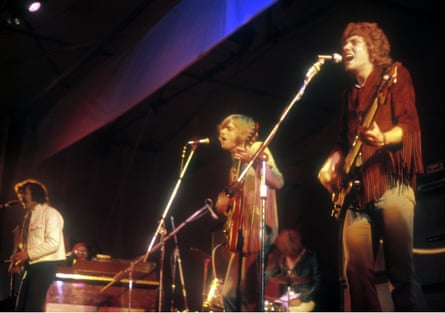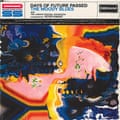If you watch any of Sky Arts’ endlessly repeated programme output, you can’t have failed at some point to chance upon the Moody Blues’ magnificent performance at the 1970 Isle of Wight pop festival. The event is best remembered now for Jimi Hendrix giving advance notice of his impending demise, and a narcoleptic Jim Morrison grunting his way through a lacklustre Doors performance, but it’s the Moodies who stole the show. They appeared on stage that August bank holiday weekend, just as the sun was going down on the Saturday evening, and, with a twilight backdrop to die for, proceeded to charm the loon pants off the crowd. And yet, despite this era-defining performance, they remain one of the last critically unrehabilitated bands of the 60s.
They are certainly not the first band you think of when compiling a list of psychedelia’s great and good, but their achievements were many. They deserve their place in my book Psychedelia and Other Colours – alongside Pink Floyd, Soft Machine and the rest of the psychedelic A-list – not least because it was in the fringes of psychedelia that much of the genre’s best music was made, often by the supposedly drug-free bands who were written off as bandwagon jumpers.
As with Fleetwood Mac, but without the casualty count and the psychodrama, the Moody Blues story is one of reinvention and renewal. By the summer of 1966, the group was all but washed up. It had been 18 months since they got to No 1 in the pop charts with their cover of the Bessie Banks R&B classic Go Now and they hadn’t had a top 10 hit since. They had been reduced to a cabaret turn on the chicken-in-a-basket circuit when they reached their nadir in Newcastle – an aggrieved punter came backstage to tell them they were the worst band he had ever seen. So lacerating was the verdict that sensitive new guitarist Justin Hayward burst into tears. The band conceded that the punter might have had a point and ditched the blue suits and corny nightclub patter, transforming themselves into cosmic troubadours. In 1967, Decca Records asked them to record an album for their Deram imprint that would show off the versatility of the label’s new Deramic Stereo Sound system. The brief was to make a pop version of Dvorak’s New World Symphony aimed at hi-fi buffs. What Decca got instead was a lushly orchestrated album of the Moodies’ own material called Days of Future Passed. Sales were reasonable but not spectacular, and the chosen single, Nights in White Satin, barely scraped into the top 20 on its first release, but the Moody Blues never played a cabaret club again.
Days of Future Passed was followed by a quartet of massively successful albums: In Search of the Lost Chord (1968); On the Threshold of a Dream (1969); To Our Children’s Children’s Children (1969); and A Question of Balance (1970). Each showcased the Moodies’ distinctive new sound – Mellotron-led, multilayered instrumentation tinged with a hint of melancholy, and banks of lusciously yearning vocals topped off with lyrics full of alliterative doggerel about man’s place in the bigger scheme of things.

Despite their success, rock critics rarely took the Moody Blues seriously, a pattern that continued for the next 45 years. This is despite their being one of the biggest attractions left from psychedelia’s first age – their last London gig, in 2013, was at the O2 arena. There was always assumed to be something a bit suspect about this physically mismatched bunch of Brummies, with their Athena poster version of pop-psych, and their songs, which offered puzzled contemplations of the riddles of the universe. When the Moodies started their own record label, Threshold, in 1969, they were photographed for the music mags sprawled on a Surrey commuter-belt lawn looking like slightly hip stockbrokers. This merely compounded the felony and they received a roasting from the more snobbish elements of the rock press.

Which is strange when you consider that the Moody Blues outlaw credentials were rock solid. They were directly implicated in the notorious three-part News of the World exposé in February 1967 on drug-taking in pop. They hung out with Jimi Hendrix, and in that Isle of Wight documentary, Justin Hayward admits to taking LSD a dozen or so times. None of the other members are exactly coy about their influences either. And how could they be when they paid blatant and unambiguous homage to the high priest of LSD, Timothy Leary, in flautist Ray Thomas’s Legend of a Mind? Keyboard player Mike Pinder’s (Thinking is) The Best Way to Travel on the In Search of a Lost Chord album is one of the great “show me the universe and get me home for tea” acid songs, and that quintet of late 60s albums is liberally peppered with memorable psychedelic moments.
Despite the critical disapproval, the best of the Moody Blues music between 1967 and 1970 possessed grace and beauty. Like the Beatles, they understood how pop songs worked as ensemble pieces. None of them were particularly virtuosic or showy as musicians and their music is refreshingly free of the noodling longeurs that characterised the output of their more self-indulgent contemporaries. And, as that Isle of Wight footage shows, unlike the majority of their peers, they could recreate their entire studio sound in live performance, sumptuous vocal harmonies, temperamental Mellotrons and all.
The Moody Blues sang of real emotions, such as loneliness and love, and trying to find one’s place in the world. And they presented their distinctive brand of everyman existentialism with infinitely more joie de vivre than, say, Pink Floyd’s Roger Waters, ELP or King Crimson. Yes, some of their lyrics were trite. And it’s not always easy to keep a straight face during some of the more purple passages, or when the drummer, Graeme Edge, recites the poems that start each album. But in the bigger cultural scheme of things, was delivering lines such as “to burst up through tarmac” in a slightly hysterical Brummie brogue any more absurd than well-bred boys from the London suburbs pretending they were Delta bluesmen?

While their lyrics were full of worried philosophising, their sound was as snug as an electric blanket. Their classical motifs are always reassuringly familiar. Everything is built on steady progressions. Nothing ever jars or wanders off into atonality. There is dissonance but no abrasion in their music. It is these components that explain both the Moodies’ massive appeal and why a certain breed of pop writer bestowed shallowness and kitsch upon them.
Those same critics now look increasingly time-warped in their appraisals of psychedelia. To younger ears, approaching this stuff for the first time, there is nothing remotely otherworldly about the vast majority of those west-coast bands who took shedloads of psychedelic drugs at the time. Dig beneath the paisley window dressing and the countercultural rhetoric and most of them sound like the folk bands they previously were and the country rock bands they were destined to become.
Instead, it is the unlikely contenders, those groups who snuck up on history’s inside lane, who now sound far out. That cross-fertilisation of the mainstream and the medicated produced some great acid pop, even if most of those who made it never touched LSD. It led to Cilla Black recording a song called Abyssinian Secret in 1968, full of nudge-nudge, wink-wink allusions about what she’d smuggled back from the far east. It resulted in Dave Dee, Dozy, Beaky, Mick and Tich B-siding the mock-exotica of Zabadak with The Sun Goes Down, a prime slice of acid-dementia that sounds like late-period Yardbirds. It led to sitars on Vince Hill records. Even Des O’Connor’s I Pretend album came dressed in the kind of swirly font that suggested he was limbering up for a guest appearance with Bubble Puppy at the Avalon Ballroom in San Francisco.
Those who sat stoned out of their minds listening to music made by people who were often fervently anti-drugs (Frank Zappa, Waters and Jethro Tull’s Ian Anderson for instance) wouldn’t have given the time of day to these fabulous forgeries. Nor would they have stopped to consider that many of the critically approved psychedelic pop singles of the late 60s were made by long-serving Tin Pan Alley arrangers and session musicians. Nirvana, for example, who made the wonderful Rainbow Chaser, had much of their carefully crafted material scored by production-line stalwarts such as Syd Dale and Johnny Scott. The lacerating guitar sound at the beginning of Smoke’s psych classic My Friend Jack was a last-minute studio suggestion by producer Monty Babson, another of the largely unsung backroom boys who gave psychedelia its inauthentic sheen.
The Bee Gees, another deeply unfashionable band with the rock cognoscenti, also made some wonderfully ersatz acid-pop in the late 60s. When Robert Wyatt, in NME in 1973, named the Bee Gees’ most psychedelically inclined album, Horizontal, as one of his 10 favourite records, he raised a few eyebrows. “No one would have said anything if I’d put John Cage or Schoenberg,” he once told me. “I always thought [the Bee Gees] were very good. But people would ask them who their heroes were and they said Winston Churchill, which didn’t resonate in the burgeoning alternative society.” So out of kilter with psych royalty were the Bee Gees that Maurice Gibb once spent an entire evening with John Lennon without realising the Beatle was tripping his face off. On another occasion, at a showbiz party, someone passed him a joint and he declined, saying: “It’s OK. I brought my own fags.” Gibb’s response was more typical that we like to think. It didn’t stop his band recording Red Chair, Fade Away, Lemons Never Forget and all the other great psych-by-numbers offerings to be found on their early albums.
In many ways, these gauche riders in the sky were psychedelia’s true heirs. Theirs is the DayGlo kingdom, the ersatz power and fabricated glory. The truth is that some immersed themselves entirely in the full lysergic experience, while others just put on a paisley shirt and looked the part. And I’m not sure it really matters which path they took. It’s hard to judge where artifice ends and authenticity begins when you are dealing with a drug that weaves hallucinatory magic and casts illusory spells. Such multilayered simulations make a mockery of the notion of “real psychedelia”. More often than not, it’s the unreal psychedelia that has endured. Or to put it more simply. What would you rather listen to? Status Quo’s Pictures of Matchstick Men? Or some Fillmore jam band meandering their way through a Bo Diddley cast-off? I thought as much.
Psychedelia and Other Colours by Rob Chapman is published by Faber. To order it for £28 (RRP £35) visit bookshop.theguardian.com or call 0330 333 6846. Free UK p&p over £10, online orders only. Phone orders min P&P of £1.99.
Ten unlikely classic psych contenders
LS Bumblebee – Peter Cook & Dudley Moore
Pictures of Today – Paul and Barry Ryan
Purple Shades – The Troggs
Abyssinian Secret – Cilla Black
Technicolour Dreams – Status Quo
Anathea – David Hemmings
Wait Til’ Tomorrow – Banana Splits
Free From the City - The Poppy Family
Mythological Sunday – Friends
Throw Down a Line – Cliff Richard and Hank Marvin

Comments (…)
Sign in or create your Guardian account to join the discussion